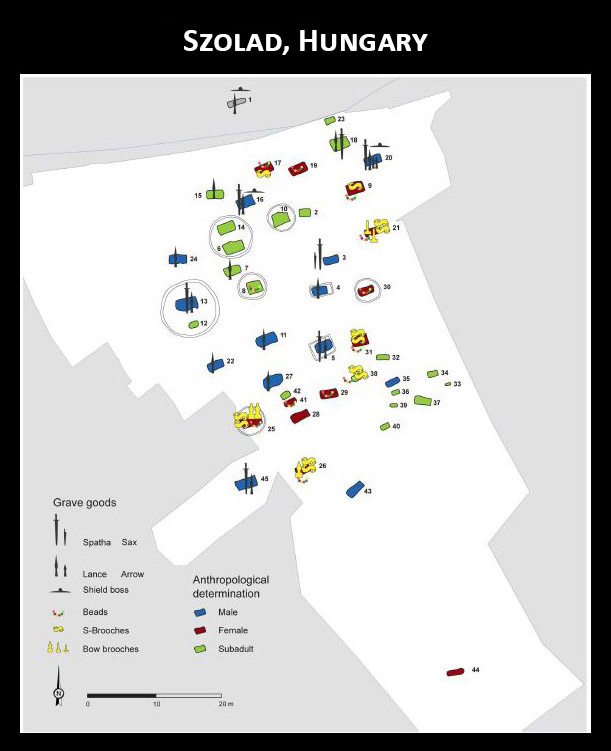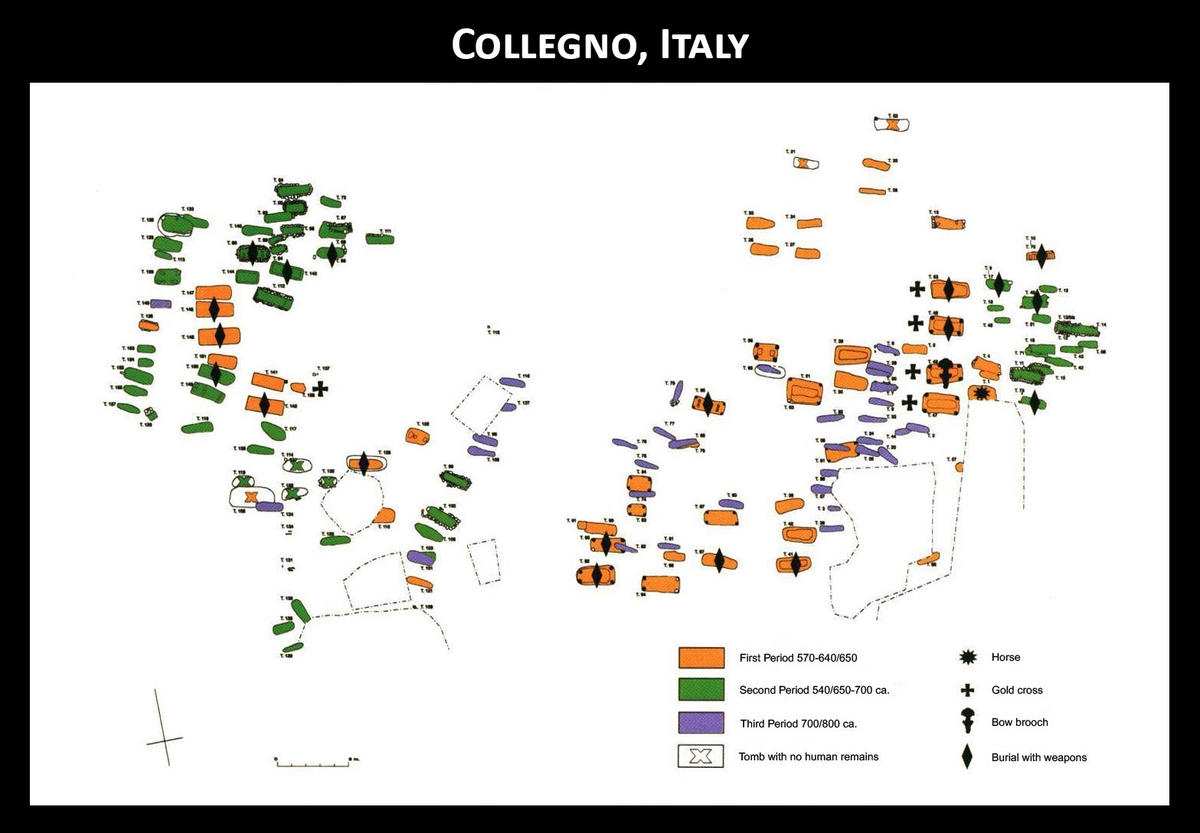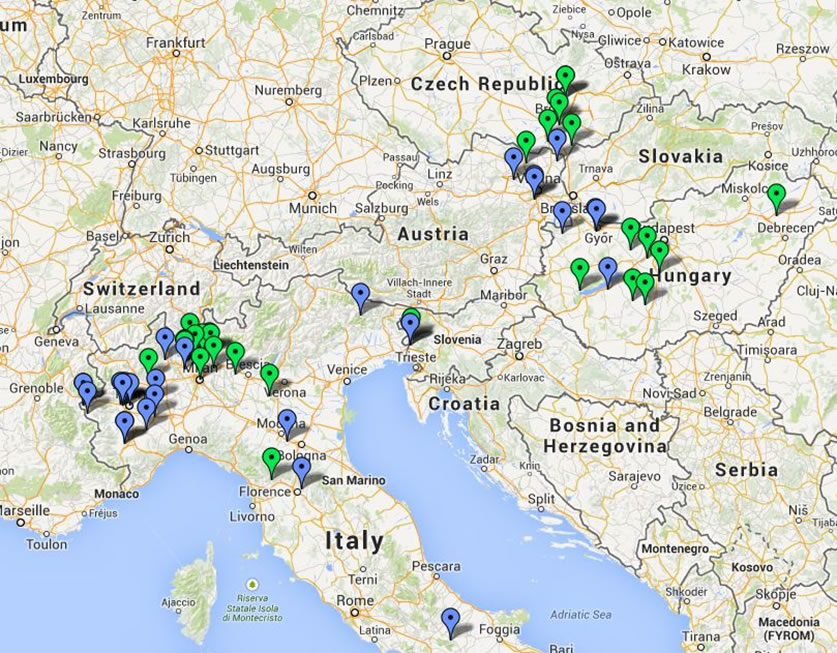Studies of ancient DNA on skeletons from two migration period cemeteries in Hungary and Italy tells us in detail about the social structure in the 6th and 7th centuries.
For some time, a group of scientists, archaeologists, and Historians have worked to explore how far studies of aDNA might help us understand the social and political situation in the migration period. More precisely, the group has been studying the composition and living circumstances of two “Longobard” settlements in respectively present-day Hungary and Northern Italy –Szólád and Collegna. Earlier studies have demonstrated that highly mobile groups of people inhabited both settlements. A new study, though, adds to the understanding of the social composition and organisations of these groups of people.
Szólád

The cemetery at Szólád lies on the southern shore of Lake Balaton in the Pannonian Basin in present-day Hungary. Written sources tell us that the Longobards who entered Northern Italy in the 560’s came from here. Studies of the human remains from the 45 graves in the cemetery constitute a first part of the on-going project intended to follow in the footsteps of people in the migration period to gain a better understanding of how the events in the 6th and 7th centuries played out.
In the first wave of DNA-studies focus was on the mitochondrial DNA. These studies, as well as Isotopic analyses, showed that the settlers presented themselves as a highly mixed group of which at least 31% died in another location than that in which they grew up. Initially, a patrilocal group settled at Szólad accompanied by a group of females deriving from a wider geographical context. Soon after, though, people moved on. The patriarchal character of the society was revealed by the fact that the males obviously had enjoyed a protein-full diet; as opposed to that of the women. “The inferred dynamics of the burial community are in agreement with hypotheses of a highly mobile lifestyle during the Migration Period and a short-term occupation of Pannonia by Lombard settlers as conveyed by written sources”, wrote the authors of the first study.
Recently, these findings have been supplemented with more deep genomic characterisation, showing that the people at Szólád could be divided into four distinct kindred-groups. The first one consisted of an alfa-male with his male children and grandchildren. All in all, descendants of four sons could be detected. Two of these sons were buried at Szólád, which also held five male grandchildren and one female descendant. These people were all buried in furnished graves, of which six were weapon-graves. One person was buried with a horse and weighing-scales. These male graves were surrounded by a smaller group of women. Unfortunately, not all of these women could be sampled. Hence, the exact relationship between these females and the youngsters buried among their male kindred could not be determined. The cemetery also held three other, yet smaller kindred-groups, typically buried with less or no stuff. Comparison of the DNA-profile of the central group of males showed its affinity to Finnish, as well as Central, Northern and Anglo-Saxon Europeans. The others carried a gene pool from southern Europe
Collegno

These studies of the people from Szólád have led to a comparison with material from another location, more precisely the remains of 57 people buried at Collegno west of Turin in Northern Italy. This cemetery held graves which could be dated between AD 580–630, based on the typologies of the artefacts found in the burials. These artefacts are similar to the types found at Szólád.
People in this cemetery at Collegno could also be divided into distinct kindred-groups, in this case, three. One of these was more prominent than the others. Albeit these people were buried in well-furnished graves as in Szólád, they were nevertheless found at Collegno to occupy spatially distinct graves. Similar to Szólád, though, this kindred also seems to derive from elsewhere. Again males seemed to derive from a northern or central European context, while females were related to a wider French or Swiss background. Also, the scientists found that the dominant kindred had profited by a diet containing more protein than its neighbours with apparent Italian ancestry.
The conclusion is that as at Szólad, Collegno was at some point “invaded” by a group of people, whose ancestors derived from a northern or central European context. While the cemetery at Szólad, however, held the burial of a primary ancestor with his descendants (three generations), the group at Collegno consisted of only two closely related generations of 2(4) grandsons plus grandchildren (with two grandsons not identified among the buried at Collegno). At Collegno, these “invaders” came to live among an already settled population of Italian descent. This conclusion is supported by the analysis of strontium, which showed that while the settlers at Szólád all seemed to come from elsewhere, this was only the case for the first generation of the dominant kindred or descent group at Collegno.
Conclusion

As is proper, the authors of this new study are careful not to press the material too much. It might be tempting to identify the two dominant kindred-groups straight away with “Longobardian” migrants with an original northern European ancestry and defined by a specific material culture and burial practice. These examples of well-armed patrilocal descent-groups may even be understood as representatives of the ‘Fara’, the famous “bands of brothers” thought of as the predominant social element of the Barbarian armies. But this is much too crude, they claim. What might perhaps at this point be concluded is the existence of at least two cases where extended migrant kindreds arrived from the outside to settle as close-knit patrilocal descent groups and also, that they may perhaps be characterised by their homogenous material culture and burial practices. “Thus our results cannot reject the migration, its route, and settlement of the “Longobards” as described in the historical texts, they write. Adding, that “since the adults were almost all non-locals, it is [also] tempting to suggest that we may be observing the historically described fara during migration.” The study, thus, throws a flame into the simmering controversy between the social constructivists of the “ethnogenesis” school of Vienna, and the ongoing reinvention of the traditional linking of ethnicity and culture. Hence, the somewhat conjectural account.
Whatever position, we take in this on-going battle, we must, nevertheless, all agree that this study offers us much upon which to reflect. Not least, the recommendation to carry out similar studies of other migration period cemeteries that we may gain a better understanding of the social dynamics and types of social organisation which characterised the settlements behind. Fortunately such studies are in the pipeline.
FEATURED PHOTO:
Elongated Skull from Collegno 6th century. Another characteristic element of the buried at Collegno was the tradition to wrap and elongate skulls. Unfortunately, the published material does not tell us which kindred at Collegno this skull belonged to. Source: Wikipedia
SOURCE:
Understanding 6th-Century Barbarian Social Organization and Migration through Paleogenomics
By Carlos Eduardo G Amorim, Stefania Vai, Cosimo Posth, Alessandra Modi, István Koncz, Susanne Hakenbeck, Maria Cristina La Rocca, Balazs Mende, Dean Bobo, Walter Pohl, Luisella Pejrani Baricco, Elena Bedini, Paolo Francalacci, Caterina Giostra, Tivadar Vida, Daniel Winger, Uta von Freeden, Silvia Ghirotto, Martina Lari, Guido Barbujani, Johannes Krause, David Caramelli, Patrick J Geary, Krishna R Veeramah
The article is published as a preprint on bioRxiv – The Preprint Server for Biology on 20.02.2018. https://doi.org/10.1101/268250
READ MORE:
Medieval Genetics. Population Mobility in the Early Middle Ages through Genomic Research
Under the direction of Professor Patrick Geary of the Institute for Advanced Study, a team of archaeologists, geneticists, and historians are undertaking genomic analysis of some 1400 individuals found in cemeteries in the Czech Republic, Hungary, Austria, and Italy in the sixth century.
READ ALSO:
The post Social Structure among the Longobards in Northern Italy in the 6th and 7th centuries appeared first on Medieval Histories.
Powered by WPeMatico